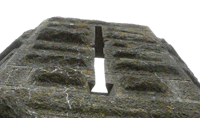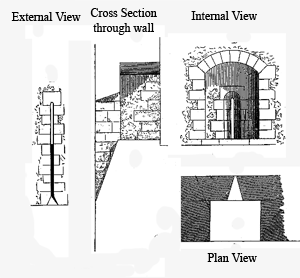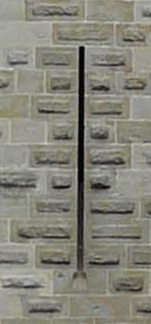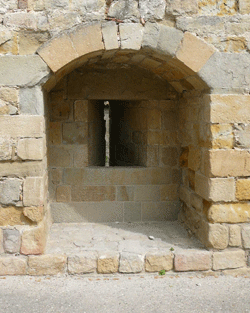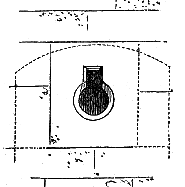
![]() Meurtrieres
- "Murder holes" - are holes designed for defenders
to kill attckers. Projectiles can be thrown or shot at the
attackers while the defenders remain relatively safe.
Meurtrieres
- "Murder holes" - are holes designed for defenders
to kill attckers. Projectiles can be thrown or shot at the
attackers while the defenders remain relatively safe.
They can conveniently be divided into two classes: holes in floors "Murder Holes" (for dropping dangerous substances or shooting at attackers) and holes in walls, such as arrow loopholes, used for shooting projectiles. For arrows they are called arrow slits or arrow loops (archeres) and for guns they are called cannoniers (canoniers)
Murder Holes
|
Attackers would naturally go for a castle's weak points, and the these weak points generally included entrances. For this reason entrance gates were heavily reinforced, often provided with extensive defensive works called barbicans. Typically the attackers would need to pass a number of obstacles, and the defenders would try to pick the attackers off as they were occupied overcoming these obstacles. Typically these obstacles would include steep inclines, ditches or moats furnished with draw bridges, and port cullises often a series of purtcullises. As attackers were finding a way through a door or portcullis they would be shot at by the defenders. A simple hole in the floor of the structure over a gateway provided a convenient way not only to shhot attackers, but also to drop things on them. |
|
|
Of course, the attackers selected the least pleasant possible items to throw on their enemies. In the popular imagination this was invariably boiling oil, but there does not appear to be a single documented insatnance of oil being used. We do however know of boiling water, molten lead, and even heated sand (all of which could penetrate armour more easily than other weapons). Other favoured materials included large stones. |
|
Arrow slits or loop-holes (archeres)
|
In addition, arrow slits were angled in such a way that they could provide cover as close as possible to the foot of the wall. As you can see from the photograph on the right, archers could achieve angles as small as 5° from the vertical. |
|
|
|
|
|
|
Arrow loops
|
|
|
Arrow loops
|
|
|
|
|
|
|
|
Cannoniers
|
Arrow loops needed altering in later times to allow their use by firearms. |
|
|
Late Medieval and Early Renaissance castles have cannoniers (for guns) rather than archeres (for arrows). You can see these at Salzes (Aude) and Mont Louis and Villefranche (PO) |
|

 Arrow
slits were not always regarded with romanic affection. In
the nineteenth century many castles were used at workshops,
stores and peasant accommodation. To keep out the weather
holes like arrow slits would often be blocked up.
Arrow
slits were not always regarded with romanic affection. In
the nineteenth century many castles were used at workshops,
stores and peasant accommodation. To keep out the weather
holes like arrow slits would often be blocked up.
On the right is an example from Carcassonne, where the slit has been filled with Toulouse brick, preserving the outline of the original hole.


